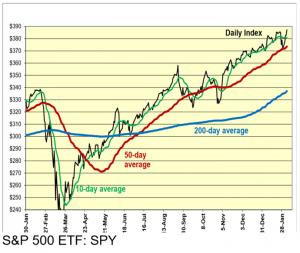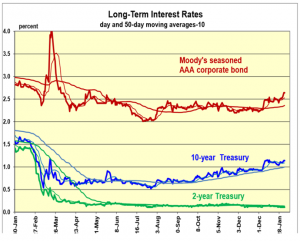Today’s report indicates job growth was minimal in January. In contrast, other reports show overall business activity in January was strong. Businesses continue to increase output without major increases in new jobs.
The Week That Was
Today’s jobs report shows private industries added a net of only 6,000 jobs in January. There was a loss of 61,000 jobs in leisure and hospitality, a significant improvement from the loss of 531,000 in December. A sharp rise in government employment led to a gain of 49,000 total jobs.
Despite the weakness in the job market, ISM business surveys for January show rapid growth in both manufacturing and service companies. Readings were in the high 50s. New orders were even stronger, with readings in the low 60s.
Initial unemployment claims remain fairly stable. The average for January was 850,000, similar to the monthly averages since October. The number of people receiving unemployment insurance payments continued to move slightly lower.
Anecdotal reports indicate the government benefits for unemployment and pandemic relief are making it harder for businesses to hire people. It’s easier to stay at home and collect a check.
Things to Come
The only economic news scheduled for next week is the report on consumer prices for January. The rapid increase in oil prices will continue to push consumer prices up. Oil prices rose by 11 percent in January and 50 percent since the election. Core inflation numbers should soon begin to reflect the upward pressure on prices.
COVID-19 Developments
COVID cases continue their rapid decline. Deaths tend to follow with a lag of about four weeks. Hence, we are on the verge a steep reduction in daily deaths. The combination of this decline and vaccinations of close to 1.5 million people a day should soon help to bring economic activity back to normal—if governments react reasonably to the facts.
Market Outlook
A combination of good news this week added to the latest euphoria surrounding stocks. Positive news on economic growth, strong earnings reports, a sharp decline in COVID cases, and progress in distributing the vaccine all helped lift stock prices.

The increase lifted the S&P500 back to 16 percent above its fundamental value. In my upcoming monthly report, we’ll look at how monetary policy has contributed to ending bull markets and highlight some of the early warning signals.
Monetary policy continues to provide a strong tailwind for stocks. Although investors are prone to react to any negative news, the tailwind from monetary policy should continue to limit any downward moves.
During the first half of this year, the economy’s momentum should enable it to grow at an annual rate of 4 percent or higher. Growth is likely to slow later this year and into the next year as new policies from the Biden administration slow the economy’s upward momentum.

As the chart above shows, long-term interest rates have begun to move higher. Without the Fed’s manipulation, the yield on 10-year Treasury notes would likely be near 4 percent. As the economy heats up and inflation increases, we face the potential for a major increase in interest rates.
Outlook
Economic Fundamentals: positive
Stock Valuation: S&P500 over-valued 16 percent
Monetary Policy: highly expansive











